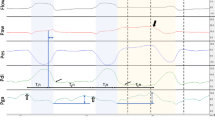Abstract
During the measurement of occluded airway pressure (Pao), the gas in the lung expands. This volume change causes Pao to underestimate the generated inspiratory muscle pressure (Pmus), which has been recommended as an index of respiratory drive. Analysis shows that the error is proportional to the thoracic gas volume at occlusion and to the effective respiratory system elastance (E ′rs ) and is inversely proportional to the dry atmospheric pressure. Examples of potential error in various species are presented. In normal human subjects at sea level measurement of Pao would underestimate Pmus on the order of 5 percent depending on E ′rs . In subjects with large functional residual capacity due to obstructive lung disease, the error can be as large as 20 percent. It is recommended that, in all studies of occlusion pressure, an estimation of this error be made.
Similar content being viewed by others
References
DuBois, A. B., S. Y. Botelho, G. N. Bendell, R. Marshall, and J. H. Comroe, Jr. A rapid plethysmo-graphic method for measuring gas — a comparison with a nitrogen washout method for measuring functional residual capacity in normal subjects.J. Clin. Invest. 35:322–326, 1956.
Eldridge, F. L. and K. Z. Vaughan. Relationship of thoracic volume and airway occlusion pressure: muscular effects.J. Appl. Physiol. 43:312–321, 1977.
Milic-Emili, J., W. A. Whitelaw, and J. P. Derenne. Occlusion, pressure — a simple measure of the respiratory center’s output.N. Eng. J. Med. 293:1029–1030, 1975.
Pengelly, L. D., J. Greene, I. Bowmar, A. Luterman, and J. Milic-Emili. Effect of added elastances on the first loaded breath in man.J. Appl. Physiol. 38:39–43, 1975.
Radford, E. P., Jr. Static mechanical properties of mammalian lungs. In:Handbook of Physiology: Respiration, edited by W. O. Fenn and H. Rahn. Washington, D. C., American Physiological Society, 1965, sect. 3, vol. 1, chapt 15, pp. 429–449.
Spells, K. E. Comparative studies in lung mechanics based on a survey of literature data.Respir. Physiol. 8:37–57, 1969.
Whitelaw, W. A., J. P. Derenne, and J. Milic-Emili. Occlusion pressure as a measure of respiratory center output in conscious man.Respir. Physiol. 23:181–199, 1975.
Author information
Authors and Affiliations
Additional information
This work was supported by the U.S. Public health Service Grants HL-19118 and HL-17689. R. L. Pimmel is supported by an RCDA (HL-00207)
Rights and permissions
About this article
Cite this article
Pimmel, R.L., Eldridge, F.L. Difference between occluded airway pressure and generated muscle pressure. Ann Biomed Eng 7, 67–72 (1979). https://doi.org/10.1007/BF02364440
Issue Date:
DOI: https://doi.org/10.1007/BF02364440




